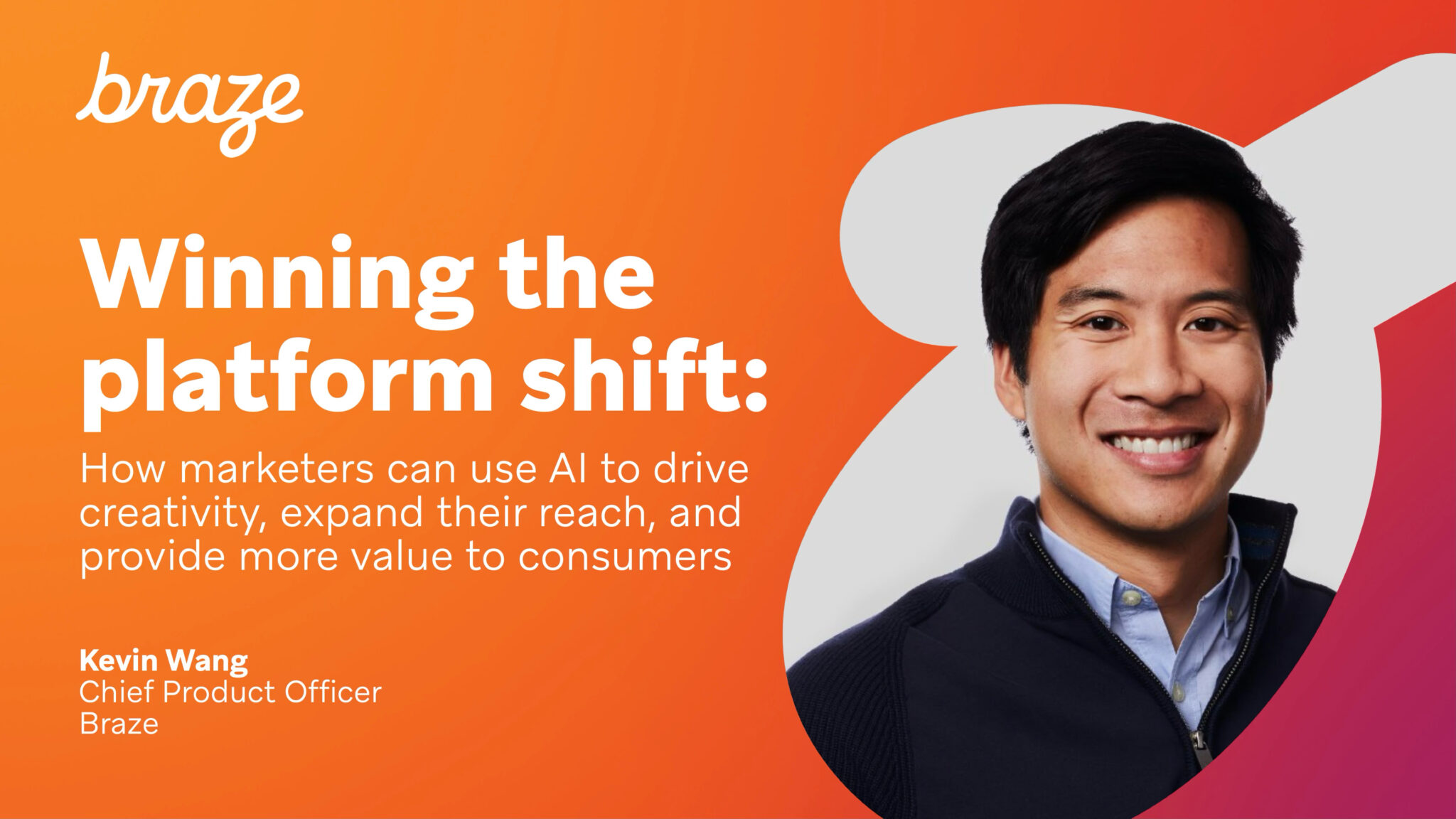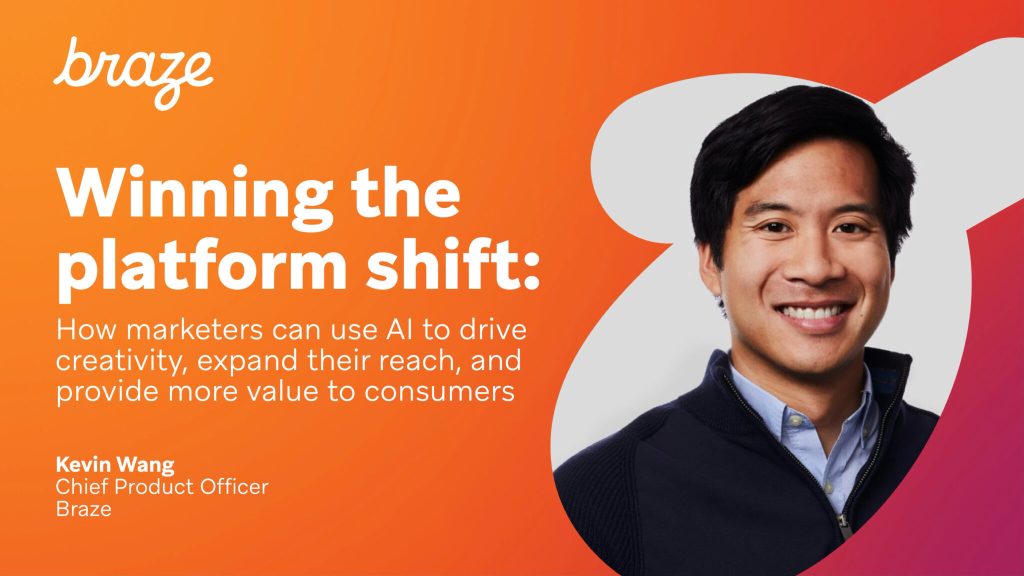Winning the platform shift by Braze


Grappling with innovation and changing consumer attitudes is second nature to marketers, who have already lived through many technological shifts over the past two decades. But forecasting where things are going is especially hard when it comes to modern AI, which has such unusual, non-deterministic properties. You can’t just extrapolate from the state of AI today to understand where AI is going to be in five years (or one…); during this sort of a platform shift, you need to take a deeper first-principles look.
Some things won’t change. Consumers will always want products, services and experiences that resonate and meet their needs. Marketers will always want easier, faster and more effective ways to connect with consumers. But the technologies that mediate that relationship are primed to shift in the coming years in major, unprecedented ways — impacting how marketers do their work, and the customer experiences they’re able to deliver.
How the marketer experience will evolve: Less rote work, more creativity
The history of marketing is built around constant evolution. But the scale and complexity of the change triggered by the rise of modern AI may test even seasoned customer engagement teams. To thrive, marketers need to open themselves up to new skills, perspectives and capabilities that will allow them to do more with less.
This change is already underway. As marketers take advantage of AI, they’re spending less time on rote tasks (like manual message creation) and more on strategy and creative work — from brainstorming innovative campaigns to deepening their testing and optimization strategy. These efficiency gains will grow as AI becomes a more prominent part of the customer engagement process, allowing brands to set goals and guardrails, then empowering their AI solutions to independently consume context, make decisions, and act on marketers’ behalf.
Today, that might look like training basic agents on your brand’s voice to ensure that message content is consistently on brand. But as we gain trust in AI’s ability to operate unsupervised over longer time horizons and to handle complex projects, more marketers will be able to shift their focus to strategy and effective management of the AI resources at their disposal to enable AI decisioning and other essential optimizations.
How team experiences will evolve: Humans and AI agents working side by side
Marketing is a collaborative art, where building a successful customer engagement program often depends as much or more on marketers’ ability to work together effectively as it does on their individual skills. But while AI may help marketers to work with internal stakeholders more effectively, its biggest unlock is the ability to be a direct “teammate” to marketers themselves. And by leveraging AI’s ability to create countless agents that can support customer engagement, even entry-level marketers will likely find themselves essentially operating as a “manager” of a team of autonomous subordinates.
Imagine creating a whole team of agents, with one tasked with personalizing product recommendations, one that QAs messages to ensure they’re formatted and built correctly, one that handles translations and another that reports back at the first sign of campaign underperformance. By supplementing your existing capabilities with agents, you aren’t just reducing the burden on yourself and your human colleagues; you’re also building a digital institutional memory, training these “teammates” with context and goals and reward functions to be able to keep supporting your efforts and driving value even as human coworkers come and go and your team’s goals shift and evolve with time.
AI and customer engagement: How brands can win the future
For years, marketers have sought the ability to truly personalize communication on a 1:1 basis across an audience of millions, and to do it swiftly, efficiently and at scale. This was the Holy Grail of marketing, but due to the limitations of technology it simply wasn’t achievable for even the most advanced teams. That’s all being made possible by AI decisioning, a powerful new type of functionality that can force multiply brands’ marketing performance and creative impact while delivering what their customers want and need.
Previously, a brand trying to win back lapsing customers had a long journey ahead of it. It might start by leveraging a churn propensity model to identify which customers are most likely to churn, then use a product prediction model to figure out what products to highlight in order to tempt them to return. From there, they’d need to run a series of A/B tests in order to figure out which offers and channels will work best. But while taking that approach is a traditional best practice, it only got brands so far — they could target micro-segments on the right channel with the right offer, but truly 1:1 engagement was still out of reach.
AI decisioning represents a new way forward when it comes to personalization. This approach leverages reinforcement learning, where AI agents learn from consumer behavior and learn over time how to maximize rewards (such as conversions or purchases) in order to optimize the KPIs that have the biggest impact through ongoing, autonomous experimentation. That means AI decisioning can seamlessly determine not only the next best product offer for those lapsing users, but also the best channel, the optimal time of day or day of week, the frequency that makes the most sense, the message most likely to drive ideal outcomes, and any other dimension that could impact whether a recipient takes a given action.
Even better, because AI agents are constantly experimenting in the background, the model can continuously adapt to shifting consumer preferences and behavior. And because these models use first-party data about every available customer characteristic, AI decisioning makes it possible to engage with individuals in a true 1:1 way, rather than relying on segments. The result is exceptional relevance and responsive experiences for individual consumers, something that’s only possible because of AI.
Final thoughts
With any major technology shift, it isn’t enough to just plan for the obvious outcomes — you must ensure you can react effectively to the changes that no one knows are coming. To succeed, brands need to pay careful attention to the arc of this new technology. Responding to a platform shift can’t be a one-and-done thing, and brands that create a five-year plan without building in regular pulse points and adjustments are going to quickly find themselves falling behind their more agile, flexible peers.
To see the full benefit of AI in their customer engagement efforts, brands also need to look beyond AI. After all, AI isn’t a shortcut, it’s an amplifier — and the AI you use for customer engagement is only ever going to be as good as the infrastructure supporting it. An exceptional AI feature isn’t going to feel exceptional to consumers if it’s built on architecture that can’t take action in real time or can only deliver experiences in a single, prescribed way. Make sure your AI tools are built on a strong foundation and have the infrastructure they need to shine; otherwise, you may never fully achieve what’s possible.
Curious to learn more about how Braze is thinking about AI and customer engagement? Check out our BrazeAIᵀᴹ page.







Recent Comments